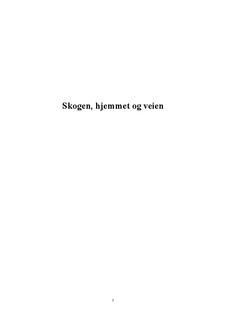| dc.description.abstract | Cultural memory has emerged as a key issue in many studies and disciplines recently. Decolonisation, new social movements, the fall of the Berlin wall and modern migration have fostered a search for alternative histories. The significance of place for memory has been considered as crucial since antiquity. Today places of memory, lieux de mémoire (Nora 2007), seem to serve as major material and immaterial anchorage points for cultures that undergo fundamental change.
This thesis explores the relationship between culture, place and memory in a literary perspective. The material for this study consists, paradoxically as it may seem, of «forgotten» regional literature from Inner Scandinavia, namely the Finn Forest. The Finn Forest has got its name from Finnish immigrants who settled in the great forests covering the county of Hedmark in Norway and the county of Värmland in Sweden from the seventeenth century onwards. At the beginning of the twentieth century the traditional Finn Forest culture was weakening due to the pressures of modernisation. In this critical period literary texts were written that focused on the relationship between culture, memory and place in the Finn Forest in different ways, both explicitly and implicitly.
Two basic assumptions lie at the heart of the theoretical and methodological approach to the chosen literary texts. First, literature shares some essential features with memory. Both literature and memory create meaning as a continued movement back and forth between past and present and between elements on different levels of the literary and the sociocultural «texts». Thus literature can be considered a model for memory. Secondly, memory’s affinity to place has always been central to the art of memory, ars memoria. Since the end of the nineteenth century a new and precarious sense of place has emerged in literature, especially in regional literature. In that respect literature can be considered as an art of memory in its own right, especially in these times of cultural distress. The literary place gives memory some provisional stability, thus enabling it to be investigated. The literary text can demonstrate how memory works and challenge dominating forms of memory with alternative interpretations of the past. Though the texts are thematically concerned with the disintegration of the traditional Finn Forest culture and the deep divide between past and present that had become apparent, the very existence of these texts nevertheless represents a continuity of the Finn Forest culture, now as a written culture with a strong sense of time and place.
The central question of investigation in this thesis is how cultural memory is inscribed in a selection of literary texts from the Finn Forest written between 1920 and 1940 by three authors, namely Olaf Hofoss (1889–1968) and Carl Vestaberg (1888–1936) from Norway and Fredrik Persson (1880–1935) from Sweden. In these texts topography and landscape are central. There are three places in particular the texts regularly focus on, namely the forest, the home and the road. The question of cultural memory is therefore concretized and operationalized in the following question: How are the Forest, the Home and the Road represented in Finn Forest literature between 1920 and 1940? The Forest, the Home and the Road are seen as representations of concrete topography as well as a set of analytical concepts, a topology.
The triad of topoi, the Forest, the Home and the Road, thus also provides the methodology for my investigation of the inscription of cultural memory in literary texts. These topoi considered as focal points of meaning in the texts, call for an analytical approach that include a variety of literary elements such as plot, setting and character as well as genre and texture which together embody the very fabric of memory. Through my unraveling and interpretation of the literary elements that make up the Forest, the Home and the Road, cultural memory comes to light in many different forms and shapes. I argue that although the texts are all deeply concerned with the fissures between the past and the present, and ingrained with loss, grief, bewilderness and ambivalence, they also invigorate memory by representing a wide range of ways to remember the past. In this way memory fills the gap between past and present and in the process makes way for the future.
The thesis aims to show how literary places record, supply and create memory for a culture. The thesis contributes to memory studies as well as to the study of place in literature and explores a methodology for an approach to literature that combines these two perspectives. Its contribution to the field of cultural memory is to show how cultural memory takes place, so to speak, in literary texts. With its focus on memory and place the thesis also contributes to the study of regional literature in general and Finn Forest literature in particular. | nb_NO |


